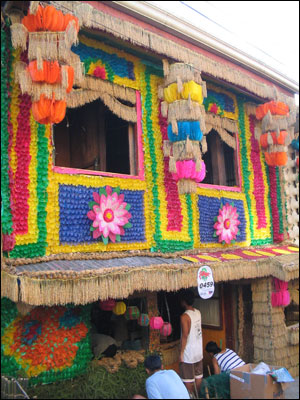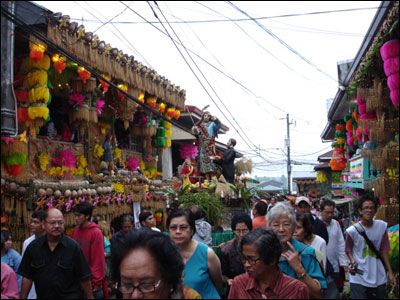
I left tayabas with some photographer friends at 3 a.m. Early you say? I was told that by 6 a.m. the roads were closed and it would be difficult to enter the town since people really come in droves to witness the Pahiyas, one of the more famous festivals in the country. If you are familiar with Discovery Channel's The Travelers, it was the festival they featured when the Philippines was in focus.
We arrived in Lucban shortly before 6 a.m. and finding parking was already a big challenge! The streets were so narrow and you had vehicles parked on both sides. Finally we found a parking space and from there we took a walk to the Lucban Church where Mass was about to begin. Although Lucban is known for the San Isidro fiesta, the church is actually dedicated to San Luis Obispo.
Pahiyas is a thanksgiving festival for a good harvest, where residents of Lucban dress up their homes with produce, flowers and plants, hats, and brightly-colored kiping or rice paste wafers shaped like leaves. Pahiyas actually means "decor" which is an apt term for the imaginative house decorations created for the festival.

After the Mass, at 7 a.m., the procession begins and the images of San Isidro Labrador and his wife, Santa Maria Torribia de la Cabeza, are brought around the decorated homes, accompanied by a marching band, to assure farmers of more bountiful harvests in the coming seasons.
Lucban is also known for its longganiza and weaving trade. That's why it is famous for hats. And I bought a lot of them! I like wearing the haciendero hat which Lucban is known for when I'm in formal or semi-formal attire and I know that I'll be out in the sun for quite a while.
After walking around Lucban for several hours, we then visited Sariaya. The architectural heritage of this town was previously unknown to me until I saw it. It was nothing but astounding! The houses were a result of the coconut boom during the First World War when coconut oil was a sought after commodity in the global market. As a result, Sariaya became a very prosperous town. And this is evident in the art deco houses that dot the area around its town plaza.
The local celebration in Sariaya is called Agawan. And just like Lucban, the houses are adorned with fruits and vegetables, rice stalks, hats, fans and brooms, sans the kiping. The festival is a way for the townsfolk to share their blessings. During the procession of the image of San Isidro, the agawan begins as the items used to decorate the house are thrown to the crowd on the street.
As one friend describes it, the agawan or in Sariayahin terms, the halbutan encapsulates the true spirit of giving and sharing of San Isidro de Labrador. As crazy and wacky as the La Tomatina of Bunol, Spain, it is the most expressive and expressed form of hospitality anywhere, aptly termed as a happy pandemonium! After partaking of Sariaya's sumptuous food, you can have your fill of a wonderful, sweaty and exciting “take home” experience that will last you a lifetime, as in fruits, veggies, money, bread, etc. being literally thrown at your feet while those gently swaying bountiful bamboo trees called bagakays are allowed to fall on the ensuing grabfest at the same time, as soon as the Poong San Isidro has blessed it, captured on camera and videos for posterity.
It was now off to Tayabas after that "refreshing" stop under the hot summer sun. And we arrived just in the nick of time since the procession was about to start!
Cheers were heard from the plaza as the image of San Isidro Labrador was brought out, carried by devotees in this all-male procession. I would consider it a much smaller yet livelier version of the Quiapo procession. What makes this procession a unique part of the Mayohan sa Tayabas, the Tayabasin celebration of the feast of San Isidro, is the hagisan ng suman. As the image passes a house, suman is thrown by its dwellers. Devotees then rush to catch the falling suman which drops from the sky like rain. It is believed that the more suman one catches, the bigger the harvest for the coming season. So expect to be shoved when the suman starts to fall, as I was shoved while taking photos! Try to stay away from the suman if you don't want to get pushed.
No comments:
Post a Comment